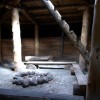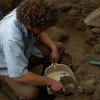In the upper Fraser Canyon, about 250 kilometers northeast of Vancouver, a rocky gorge cuts its way through the interior plateau of British Columbia.
Gordon Orians, professor emeritus of biology at the University of Washington, and I have come here to see evidence of the emergence of inequality in the archaeological record of fishing at a place called Keatley Creek.
Gordon is my science adviser and co-producer on a multimedia project in which we’re investigating the evolution of the human sense of fairness, from its biological roots among the earliest social living animals through its manifestations in the social, economic, and political institutions of today.
Inequality, of course, is not necessarily unfair. Fairness has to do with the process through which it evolves.
Fairness is a term much bandied about in these economic hard times, though people argue vehemently over what is actually fair. We thought it would be helpful to explore the concept of fairness in greater depth, from a scientific perspective.
The growing body of research into the nature of fairness includes disciplines such as behavioral genetics, evolutionary and developmental psychology, neuroscience, animal behavior, experimental economics, and some intriguing cross-disciplinary collaborations.
One of the central topics we plan to investigate is how our sense of fairness may have changed during the last 10,000 years of cultural evolution, after having lived the previous 2,000,000 as nomadic hunter-gatherers, typically in groups of 25 to 50 who were closely interrelated.
A significant amount of evidence indicates that during those 2,000,000 years, we evolved a finely tuned set of social skills and preferences that enabled us to live successfully in groups. These behavioral and emotional characteristics are in part genetically encoded and are integral components of our sense of fairness today. But this has been only one of the influences on the fairness of societies since cultural evolution got underway.
Keatley Creek seemed like a good place to begin our investigation, since a cultural transition that took place there thousands of years ago marked a turning point in how the people who lived there may have thought about fairness. Similar cultural changes have been documented by archaeologists and ethnographers around the world.
Here, Brian Hayden, professor emeritus of archaeology at Simon Fraser University, showed us scores of circular bowl-like depressions of varying size, between 10 and 20 meters in diameter.
Each of the shallow depressions was the remnant of a pit house, a common style of primitive construction. There would have been a timber and earth structure above, though the pits are all that remain. However, beneath each pit and its surrounding rim is a trove of discarded material and artifacts that has lain buried for thousands of years. Brian began excavating the site in 1986, and in the last quarter century has developed a picture of what life was like for the people of Keatley Creek. One of his central discoveries is evidence of a simple class structure and an unequal distribution of wealth.
Nomadic hunter-gatherers were essentially egalitarian. They lived at a subsistence level, with starvation only the next drought away. Resources were shared, because sharing maximizes the chances of survival for the group as a whole. Hoarding—co-opting resources for private use—was socially unacceptable. Individual ambition was suppressed, because it would disrupt the group cohesion necessary for survival. Economic competition didn’t exist.
The combination of the Fraser River’s abundant salmon and consistent warm winds to dry caught fish made the Keatley Creek location a key fishing location for thousands of years and into the present. (Photo by Suzanne Villeneuve)

About 40,000 years ago humans began developing more complex tools and behaviors, and about 10,000 years ago, agriculture and animal domestication. For a long time researchers believed that these latter innovations, by greatly increasing the volume, reliability, and storability of food resources, were prerequisites for the development of socioeconomic inequality. However, the people of Keatley Creek still made their living by hunting, foraging, and most importantly for this story, fishing. They didn’t have agriculture or domesticated animals, except for dogs. What spurred the rise of inequality in that setting?
A key factor seems to have been salmon, which are abundant in the Fraser River. They are readily preserved by drying, and warm winds during the fishing season provide an ideal natural dehydrator. Salmon provided a reliable surplus of storable food that enabled the people of Keatley Creek to settle, eventually building a village where they could hunker down for the cold, dark winter of the British Columbia interior and still have enough to eat.
Brian’s work led him to a theory of how the people of Keatley Creek evolved strategies for sharing this bounty, and in the conclusion, we investigate its implications for the challenges of inequality today.
A Multimedia Presentation:
The River to Fairness
Follow the links below to a series of short stories and videos describing the chronological evolution of Brian Hayden’s approach and ultimately the evolution of fairness.
Fishing Rocks
These shelves are known as fishing rocks, where the migrating fish can be efficiently harvested with dip nets, a simple technology that has changed little over thousands of years. Read more
The Path to Keatley Creek
As people discovered the fishing rocks and the bounty that could be harvested each year, when, and why, did the changes in their culture begin? Read More
The Pit House
What was life like in these transegalitarian societies, with large households encompassing two unequal classes? Read more

House Pit Seven
The dry climate provided excellent preservation of material, even organic remains such as fish bones. Read more
Artifacts
Prestige goods play an important role in the growth of inequality. Read more
Two Paths to Inequality
Since everyone’s share is bigger, the community would not begrudge the benefactor a slightly larger slice. Read more
How Inequality Began
These individuals, called “aggrandizers,” exploited the surplus to their own advantage, and in so doing, raised the survival odds for themselves and their offspring, becoming winners in this most basic of evolutionary games. Read more

Seeing Fairness Evolve
Slowly, through a variety of strategies such as bride prices and competitive feasts, aggrandizers consolidated their power. Read more
Conclusion: The Judgment of Fairness
It’s a system that tends to concentrate power in the hands of a few, but it’s simply a consequence of the natural variability in human personality evolving in conditions of surplus. Read more





